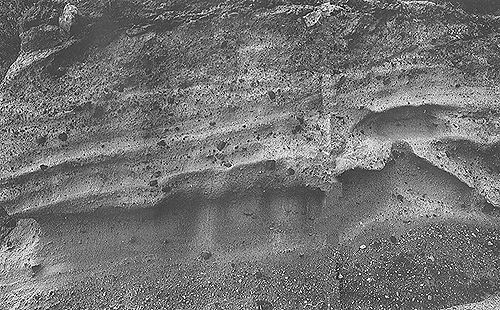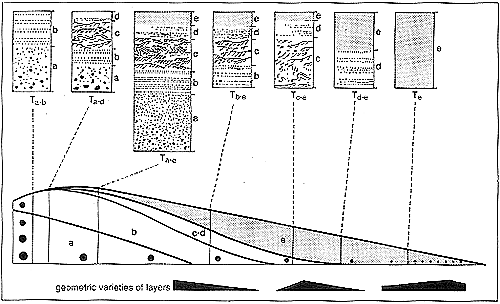

Normal and inverted grading
Plate 69


Normal and inverted grading
Plate 69
Pyroclastic materials form this outcrop, a roadcut in the island of Salina, Tyrrhenian Sea. Two superposed depositional units, separated by an irregular surface, display opposite types of vertical grading, emphasized by coarse clasts (lapilli and lava fragments).
The lower unit is a normally graded bed, faintly laminated in the upper part. The upper unit is clinostratified and reversely graded. Dealing with volcano-derived materials, one can suspect that normal grading was caused by ballistic fall. If it were so, fine ash would lag behind the coarser particles and be sprinkled on top of them. Instead, they are mixed together, which means that they were suspended and mixed in a turbulent cloud. The effect of turbulence, in fact, is to uniformly distribute the finer materials within the flow, whereas the heavier particles are concentrated near the bottom. When the velocity and the carrying capacity decrease, the fall of coarse grains entrains part of the fine ash traveling at low levels.
Reverse grading, culminating with some floating blocks on top of the deposit, is a spy to a different mechanism: a laminar, semi-coherent flow with a higher concentration of solid particles. This is a pyroclastic flow, i.e., a hot, gravity-driven suspension deriving directly from the volcanic vent or from a convective gas column, or a cold debris flow, wet or dry. Turbulence does not develop, or is choked, when viscosity is high, and heavier particles are supported by the matrix strength (cohesion). Macroscopical characters are not sufficient to reveal whether the flow was pyroclastic or not: textures and structures are the same in both cases. One must look for some specific indicators, such as the presence of vegetal debris (if it is charred, the flow was hot) and small aggregates of ash called accretionary lapilli (see plate 166), which are fragile and easily destroyed when the ash is remobilized. For more information on these processes, see introductory section.